Bioremediation of Explosive TNT by Trichoderma viride
Abstract
1. Introduction
2. Results and Discussion
2.1. Screening of Fungal Growth on TNT-Containing Media
2.2. Determination of TNT and Metabolites by GC/MS Analysis
3. Material and Methods
3.1. Chemicals and Biological Materials
3.1.1. Chemicals and Preparations
3.1.2. T. viride Specimens
3.2. Screening of Fungal Growth on TNT Containing Media
3.3. Determination of TNT and Metabolites by GC/MS Analysis
4. Conclusions
Author Contributions
Funding
Acknowledgments
Conflicts of Interest
References
- Bruns-Nagel, D.; Breitung, J.; Von Low, E.; Steinbach, K.; Gorontzy, T.; Kahl, M.; Blotevogel, K.; Gemsa, D. Microbial transformation of 2, 4, 6-trinitrotoluene in aerobic soil columns. Appl. Environ. Microbiol. 1996, 62, 2651–2656. [Google Scholar] [CrossRef] [PubMed]
- Weiß, M.; Geyer, R.; Russow, R.; Richnow, H.H.; Kästner, M. Fate and metabolism of [15N] 2,4,6-trinitrotoluene in soil. Env. Toxicol Chem. 2004, 23, 1852–1860. [Google Scholar] [CrossRef] [PubMed]
- Williams, R.E.; Rathbone, D.A.; Scrutton, N.S.; Bruce, N.C. Biotransformation of explosives by the old yellow enzyme family of flavoproteins. Appl. Environ. Microbiol. 2004, 70, 3566–3574. [Google Scholar] [CrossRef] [PubMed]
- Daun, G.; Lenke, H.; Reuss, M.; Knackmuss, H.-J. Biological treatment of TNT-contaminated soil. 1. Anaerobic cometabolic reduction and interaction of TNT and metabolites with soil components. Environ. Sci. Technol 1998, 32, 1956–1963. [Google Scholar] [CrossRef]
- Vorbeck, C.; Lenke, H.; Fischer, P.; Spain, J.C.; Knackmuss, H.-J. Initial reductive reactions in aerobic microbial metabolism of 2, 4, 6-trinitrotoluene. Appl. Environ. Microbiol. 1998, 64, 246–252. [Google Scholar] [CrossRef]
- Esteve-Núñez, A.; Ramos, J.L. Metabolism of 2,4,6-trinitrotoluene by Pseudomonas sp. JLR11. Environ. Sci. Technol 1998, 32, 3802–3808. [Google Scholar] [CrossRef]
- Esteve-Núñez, A.; Caballero, A.; Ramos, J.L. Biological degradation of 2,4,6-trinitrotoluene. Microbiol. Mol. Biol. Rev. 2001, 65, 335–352. [Google Scholar] [CrossRef]
- Ayoub, K.; van Hullebusch, E.D.; Cassir, M.; Bermond, A. Application of advanced oxidation processes for TNT removal: A review. J. Hazard. Mater. 2010, 178, 10–28. [Google Scholar] [CrossRef]
- Habineza, A.; Zhai, J.; Mai, T.; Mmereki, D.; Ntakirutimana, T. Biodegradation of 2,4,6-trinitrotoluene (TNT) in contaminated soil and microbial remediation options for treatment. Period. Polytech. Chem. Eng. 2017, 61, 171–187. [Google Scholar]
- Kulkarni, M.; Chaudhari, A. Microbial remediation of nitro-aromatic compounds: An overview. J. Environ. Manag. 2007, 85, 496–512. [Google Scholar] [CrossRef]
- Mercimek, H.A.; Dincer, S.; Guzeldag, G.; Ozsavli, A.; Matyar, F. Aerobic biodegradation of 2,4,6-trinitrotoluene (TNT) by Bacillus cereus isolated from contaminated soil. Microb. Ecol. 2013, 66, 512–521. [Google Scholar] [CrossRef] [PubMed]
- Chien, C.C.; Kao, C.M.; Chen, D.Y.; Chen, S.C.; Chen, C.C. Biotransformation of trinitrotoluene (TNT) by Pseudomonas spp. isolated from a TNT-contaminated environment. Environ. Sci. Technol 2014, 33, 1059–1063. [Google Scholar]
- Bernstein, A.; Ronen, Z. Biodegradation of the explosives TNT, RDX and HMX. In Microbial Degradation of Xenobiotics; Springer: Berlin, Germany, 2012; pp. 135–176. [Google Scholar]
- Fahrenfeld, N.; Zoeckler, J.; Widdowson, M.A.; Pruden, A. Effect of biostimulants on 2,4,6-trinitrotoluene (TNT) degradation and bacterial community composition in contaminated aquifer sediment enrichments. Biodegradation 2013, 24, 179–190. [Google Scholar] [CrossRef]
- Pichtel, J. Distribution and fate of military explosives and propellants in soil: A review. App. Environ. Soil Sci. 2012, 1–33. [Google Scholar] [CrossRef]
- Khan, M.I.; Lee, J.; Park, J. A toxicological review on potential microbial degradation intermediates of 2, 4, 6-trinitrotoluene, and its implications in bioremediation. Ksce J. Civ. Eng. 2013, 17, 1223–1231. [Google Scholar] [CrossRef]
- EPA. Technical fact sheet-2,4,6-Trinitrotoluene (TNT). In Office of Solid Waste and Emergency Response (5106P); United States Environmental Protection Agency: Washington, DC, USA, 2014. [Google Scholar]
- Mercimek, H.A.; Dincer, S.; Guzeldag, G.; Ozsavli, A.; Matyar, F.; Arkut, A.; Kayis, F.; Ozdenefe, M.S. Degradation of 2, 4, 6-trinitrotoluene by P. aeruginosa and characterization of some metabolites. Braz. J. Microbiol. 2015, 46, 103–111. [Google Scholar] [CrossRef]
- Kalderis, D.; Juhasz, A.L.; Boopathy, R.; Comfort, S. Soils contaminated with explosives: Environmental fate and evaluation of state-of-the-art remediation processes (IUPAC technical report). Pure Appl. Chem. 2011, 83, 1407–1484. [Google Scholar] [CrossRef]
- Phillips, C.T.; Checkai, R.T.; Kuperman, R.G.; Simini, M.; Sunahara, G.I.; Hawari, J. Toxicity Determinations for Five Energetic Materials, Weathered and Aged in Soil, to the Collembolan Folsomia candida; Army Edgewood Chemical Biological Center Apg Md Research And Technology Dir: Aberdeen, MD, USA, 2015. [Google Scholar]
- Kuperman, R.G.; Checkai, R.T.; Simini, M.; Phillips, C.T.; Kolakowski, J.E.; Lanno, R. Soil properties affect the toxicities of 2, 4, 6-trinitrotoluene (TNT) and hexahydro-1, 3, 5-trinitro-1, 3, 5-triazine (RDX) to the enchytraeid worm Enchytraeus crypticus. Env. Toxicol Chem. 2013, 32, 2648–2659. [Google Scholar]
- Rodgers, J.D.; Bunce, N.J. Treatment methods for the remediation of nitroaromatic explosives. Water Res. 2001, 35, 2101–2111. [Google Scholar] [CrossRef]
- Rajasekar, A.; Maruthamuthu, S.; Ting, Y.-P.; Balasubramanian, R.; Rahman, P.K. Bacterial degradation of petroleum hydrocarbons. In Microbial Degradation of Xenobiotics; Springer: Berlin, Germany, 2012; pp. 339–369. [Google Scholar]
- Ziganshin, A.M.; Naumova, R.P.; Pannier, A.J.; Gerlach, R. Influence of pH on 2, 4, 6-trinitrotoluene degradation by Yarrowia lipolytica. Chemosphere 2010, 79, 426–433. [Google Scholar] [CrossRef]
- Kubota, A.; Maeda, T.; Nagafuchi, N.; Kadokami, K.; Ogawa, H.I. TNT biodegradation and production of dihydroxylamino-nitrotoluene by aerobic TNT degrader Pseudomonas sp. strain TM15 in an anoxic environment. Biodegradation 2008, 19, 795. [Google Scholar] [CrossRef] [PubMed]
- Perelo, L.W. In situ and bioremediation of organic pollutants in aquatic sediments. J. Hazard. Mater. 2010, 177, 81–89. [Google Scholar] [CrossRef] [PubMed]
- Singh, S.N. Microbial Degradation of Xenobiotics; Springer: Berlin, Germany, 2011. [Google Scholar]
- Blotevogel, K.H.; Gorontzy, T. Microbial degradation of compounds with nitro functions. Biotechnol. Set 2001, 273–302. [Google Scholar]
- Boopathy, R.; Kulpa, C.F. Biotransformation of 2,4,6-trinitrotoluene (TNT) by a Methanococcus sp.(strain B) isolated from a lake sediment. Can. J. Microbiol. 1994, 40, 273–278. [Google Scholar] [CrossRef]
- Duque, E.; Haidour, A.; Godoy, F.; Ramos, J.L. Construction of a Pseudomonas hybrid strain that mineralizes 2, 4, 6-trinitrotoluene. J. Bacteriol. 1993, 175, 2278–2283. [Google Scholar] [CrossRef]
- Esteve-Nuñez, A.; Lucchesi, G.; Philipp, B.; Schink, B.; Ramos, J.L. Respiration of 2, 4, 6-Trinitrotoluene by Pseudomonas sp. Strain JLR11. J. Bacteriol. 2000, 182, 1352–1355. [Google Scholar] [CrossRef] [PubMed]
- Shen, C.; Hawari, J.; Ampleman, G.; Thiboutot, S.; Guiot, S. Origin of p-cresol in the anaerobic degradation of trinitrotoluene. Can. J. Microbiol.Y 2000, 46, 119–124. [Google Scholar] [CrossRef] [PubMed]
- Lewis, T.; Ederer, M.; Crawford, R.; Crawford, D. Microbial transformation of 2, 4, 6-trinitrotoluene. J. Ind. Microbiol. Biotechnol. 1997, 18, 89–96. [Google Scholar] [CrossRef]
- Spain, J.C. Biodegradation of nitroaromatic compounds. Annu. Rev. Microbiol. 1995, 49, 523–555. [Google Scholar] [CrossRef]
- Fritsche, W.; Scheibner, K.; Herre, A.; Hofrichter, M. Fungal Degradation of Explosives: TNT and Related Nitroaromatic Compounds; CRC Press: Boca Raton, FL, USA, 2000. [Google Scholar]
- Hatzinger, P.B.; Fuller, M.E.; Rungmakol, D.; Schuster, R.L.; Steffan, R.J. Enhancing the attenuation of explosives in surface soils at military facilities: Sorption-desorption isotherms. Env. Toxicol Chem. 2004, 23, 306–312. [Google Scholar] [CrossRef]
- Fuller, M.E.; Manning, J.F., Jr. Aerobic gram-positive and gram-negative bacteria exhibit differential sensitivity to and transformation of 2,4,6-trinitrotoluene (TNT). Curr. Microbiol. 1997, 35, 77–83. [Google Scholar] [CrossRef] [PubMed]
- George, I.; Eyers, L.; Stenuit, B.; Agathos, S.N. Effect of 2,4,6-trinitrotoluene on soil bacterial communities. Ind. Microbiol. Biotechnol. 2008, 35, 225–236. [Google Scholar] [CrossRef] [PubMed]
- Wittich, R.-M.; Ramos, J.L.; Dillewijn, P.v. Microorganisms and explosives: Mechanisms of nitrogen release from TNT for use as an N-source for growth. Environ. Sci. Technol. 2009, 43, 2773–2776. [Google Scholar] [CrossRef] [PubMed]
- Weber, R.W.; Ridderbusch, D.C.; Heidrun, A. 2,4,6-Trinitrotoluene (TNT) tolerance and biotransformation potential of microfungi isolated from TNT-contaminated soil. Mycol. Res. 2002, 106, 336–344. [Google Scholar] [CrossRef]
- Bhatt, M.; Zhao, J.-S.; Halasz, A.; Hawari, J. Biodegradation of hexahydro-1, 3, 5-trinitro-1, 3, 5-triazine by novel fungi isolated from unexploded ordnance contaminated marine sediment. J. Ind. Microbiol. Biotechnol. 2006, 33, 850. [Google Scholar] [CrossRef]
- Scheibner, K.; Hofrichter, M.; Herre, A.; Michels, J.; Fritsche, W. Screening for fungi intensively mineralizing 2, 4, 6-trinitrotoluene. Appl. Microbiol Biotechnol. 1997, 47, 452–457. [Google Scholar] [CrossRef]
- Samson, J.; Langlois, É.; Lei, J.; Piché, Y.; Chênevert, R. Removal of 2, 4, 6-trinitrotoluence and 2, 4-dinitrotoluene by fungi (Ceratocystis coerulescens, Lentinus lepideus and Trichoderma harxianum). Biotechnol. Lett. 1998, 20, 355–358. [Google Scholar] [CrossRef]
- Hawari, J. Biodegradation of RDX and HMX: From basic research to field application. In Biodegradation of Nitroaromatic Compounds and Explosives; CRC Press: Boca Raton, FL, USA, 2000. [Google Scholar]
- Hawari, J.; Beaudet, S.; Halasz, A.; Thiboutot, S.; Ampleman, G. Microbial degradation of explosives: Biotransformation versus mineralization. Appl. Microbiol. Biotechnol. 2000, 54, 605–618. [Google Scholar] [CrossRef]
- Gunnison, D.; Pennington, J.C.; Price, C.B.; Myrick, G.B. Screening test and isolation procedure for TNT-degrading microorganisms. Us Army 1993, 11, 11. [Google Scholar]
- Robertson, B.; Jjemba, P.K. Enhanced bioavailability of sorbed 2,4,6-trinitrotoluene (TNT) by a bacterial consortium. Chemosphere 2005, 58, 263–270. [Google Scholar] [CrossRef]
- Claus, H. Microbial degradation of 2,4,6-trinitrotoluene in vitro and in natural environments. In Biological Remediation of Explosive Residues; Springer: Berlin, Germany, 2014; pp. 15–38. [Google Scholar]
- Sheremata, T.W.; Thiboutot, S.; Ampleman, G.; Paquet, L.; Halasz, A.; Hawari, J. Fate of 2,4,6-trinitrotoluene and its metabolites in natural and model soil systems. Environ. Sci. Technol 1999, 33, 4002–4008. [Google Scholar] [CrossRef]
- Heiss, G.; Knackmuss, H.-J. Bioelimination of trinitroaromatic compounds: Immobilization versus mineralization. Curr. Opin. Microbiol. 2002, 5, 282–287. [Google Scholar] [CrossRef]
- Gallagher, E.M.; Young, L.Y.; McGuinness, L.M.; Kerkhof, L.J. Detection of 2, 4, 6-trinitrotoluene-utilizing anaerobic bacteria by 15N and 13C incorporation. Appl. Environ. Microbiol. 2010, 76, 1695–1698. [Google Scholar] [CrossRef] [PubMed]
- Michels, J.; Gottschalk, G. Pathway of 2,4,6-trinitrotoluene (TNT) degradation by Phanerochaete chrysosporium. In Biodegradation of Nitroaromatic Compounds; Springer: Berlin, Germany, 1995; pp. 135–149. [Google Scholar]
- Oh, B.-t.; Shea, P.J.; Drijber, R.A.; Vasilyeva, G.K.; Sarath, G. TNT biotransformation and detoxification by a Pseudomonas aeruginosa strain. Biodegradation 2003, 14, 309–319. [Google Scholar] [CrossRef] [PubMed]
- Riggle, P.J.; Kumamoto, C.A. Role of a Candida albicans P1-type ATPase in resistance to copper and silver ion toxicity. J. Bacteriol. 2000, 182, 4899–4905. [Google Scholar] [CrossRef]
- Tsezos, M.; Volesky, B. Biosorption of uranium and thorium. Biotechnol. Bioeng. 1981, 23, 583–604. [Google Scholar] [CrossRef]
- Gadd, G.M.; White, C. Microbial treatment of metal pollution—a working biotechnology? Trends Biotechnol. 1993, 11, 353–359. [Google Scholar] [CrossRef]
- Texier, A.-C.; Andrès, Y.; Le Cloirec, P. Selective biosorption of lanthanide (La, Eu, Yb) ions by Pseudomonas aeruginosa. Environ. Sci. Technol 1999, 33, 489–495. [Google Scholar] [CrossRef]
- Bayman, P.; Ritchey, S.; Bennett, J. Fungal interactions with the explosive RDX (hexahydro-1,3,5-trinitro-1, 3, 5-triazine). J. Ind. Microbiol. 1995, 15, 418–423. [Google Scholar] [CrossRef]
- Rosenblatt, D.H.; Burrows, E.P.; Mitchell, W.R.; Parmer, D.L. Organic explosives and related compounds. In Anthropogenic Compounds; Springer: Berlin, Germany, 1991; pp. 195–234. [Google Scholar]
- Siddiquee, S.; Cheong, B.E.; Taslima, K.; Kausar, H.; Hasan, M.M. Separation and identification of volatile compounds from liquid cultures of Trichoderma harzianum by GC-MS using three different capillary columns. J. Chromatogr. Sci. 2012, 50, 358–367. [Google Scholar] [CrossRef]
- Stoppacher, N.; Kluger, B.; Zeilinger, S.; Krska, R.; Schuhmacher, R. Identification and profiling of volatile metabolites of the biocontrol fungus Trichoderma atroviride by HS-SPME-GC-MS. J. Microbiol. Methods. 2010, 81, 187–193. [Google Scholar] [CrossRef] [PubMed]
Sample Availability: Samples of the compounds in this study are available from the corresponding author on request. |
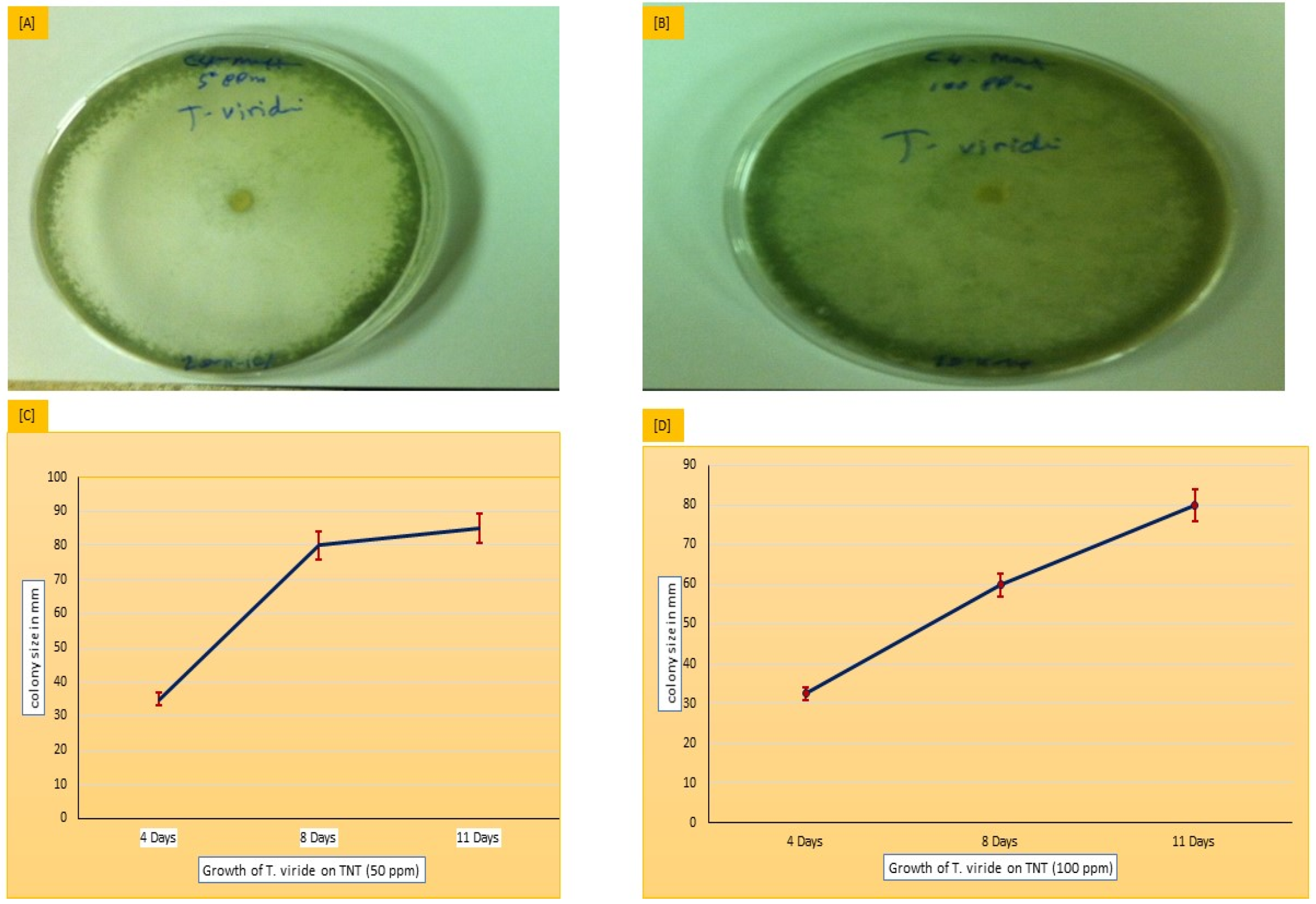
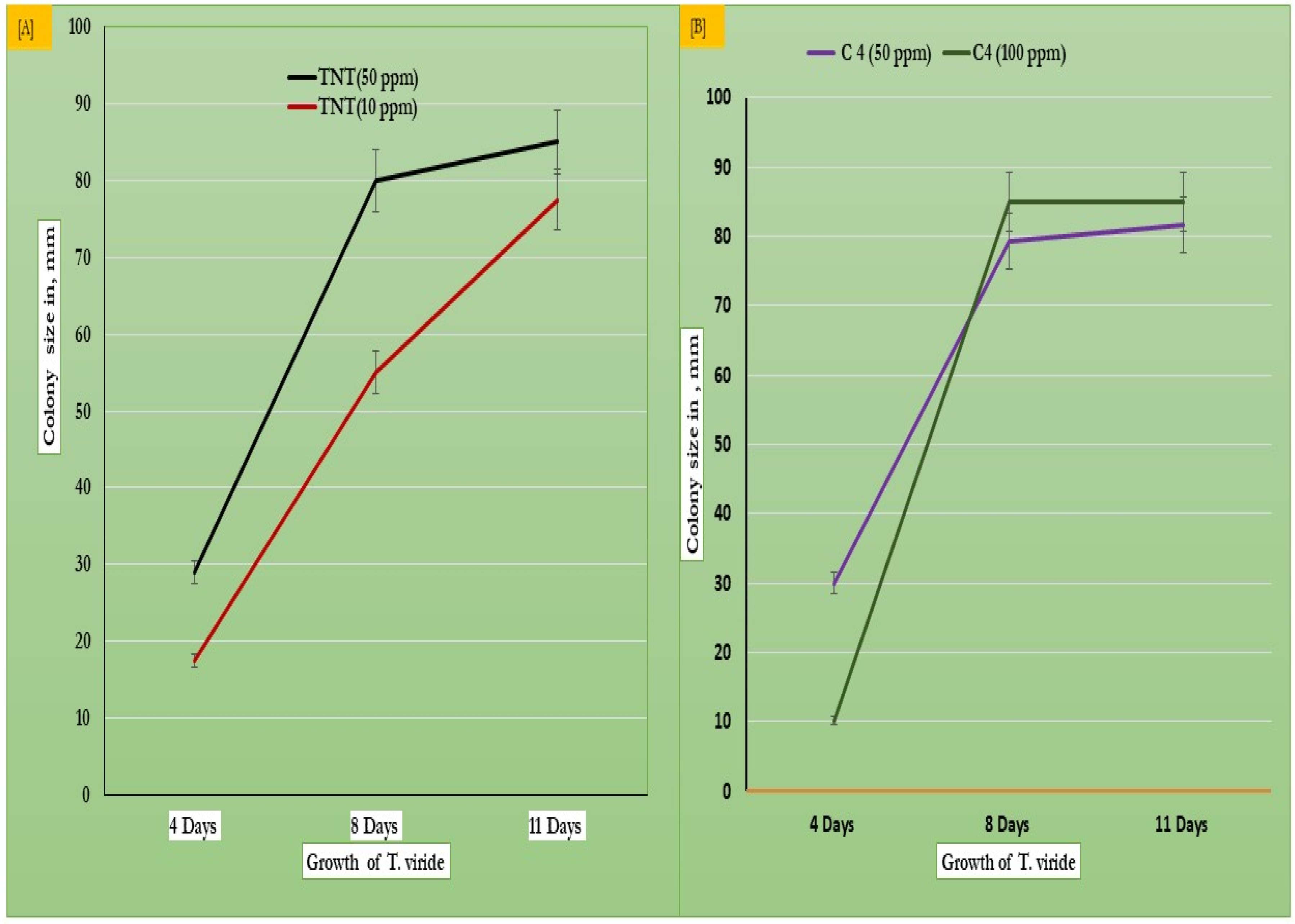
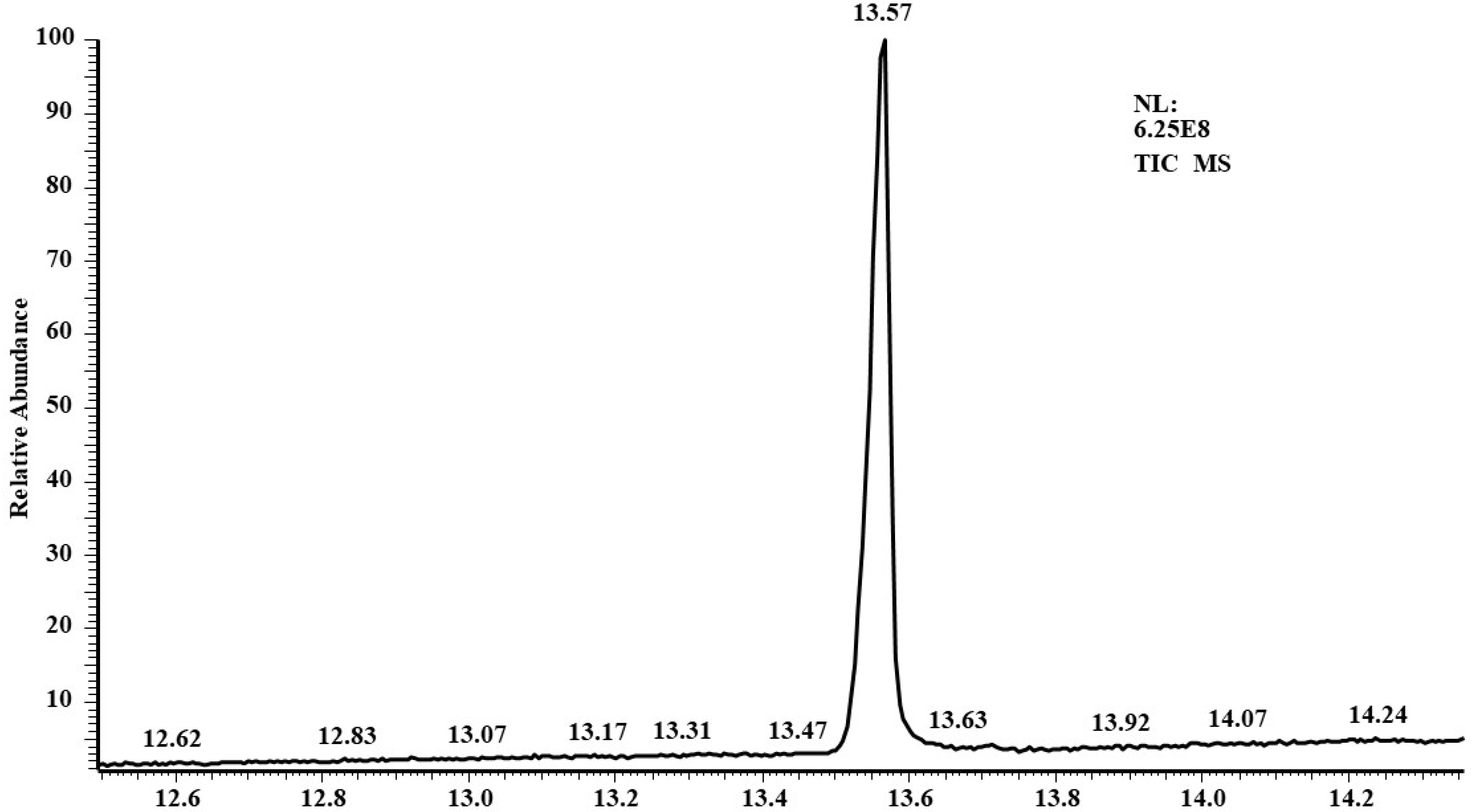
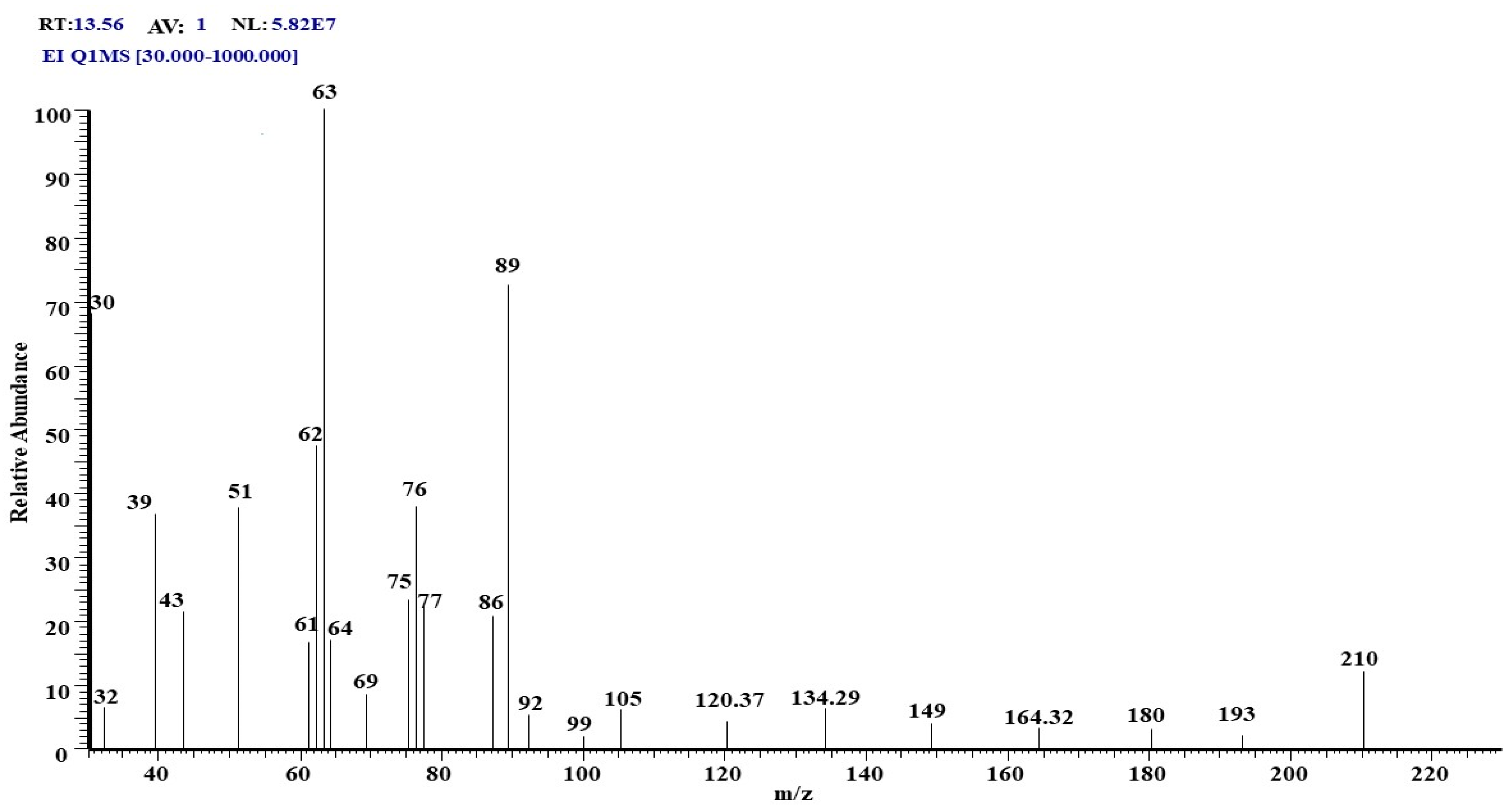
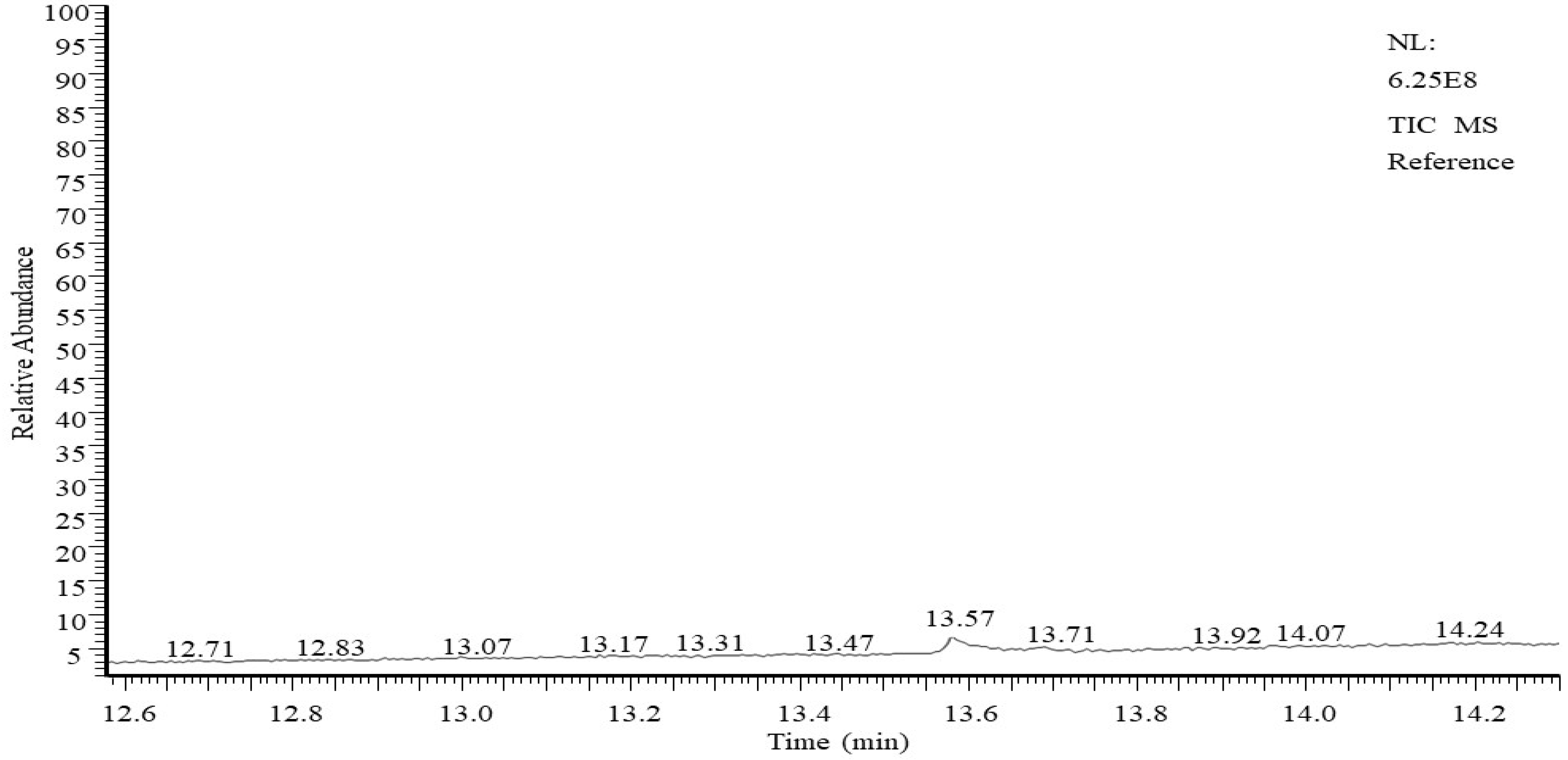
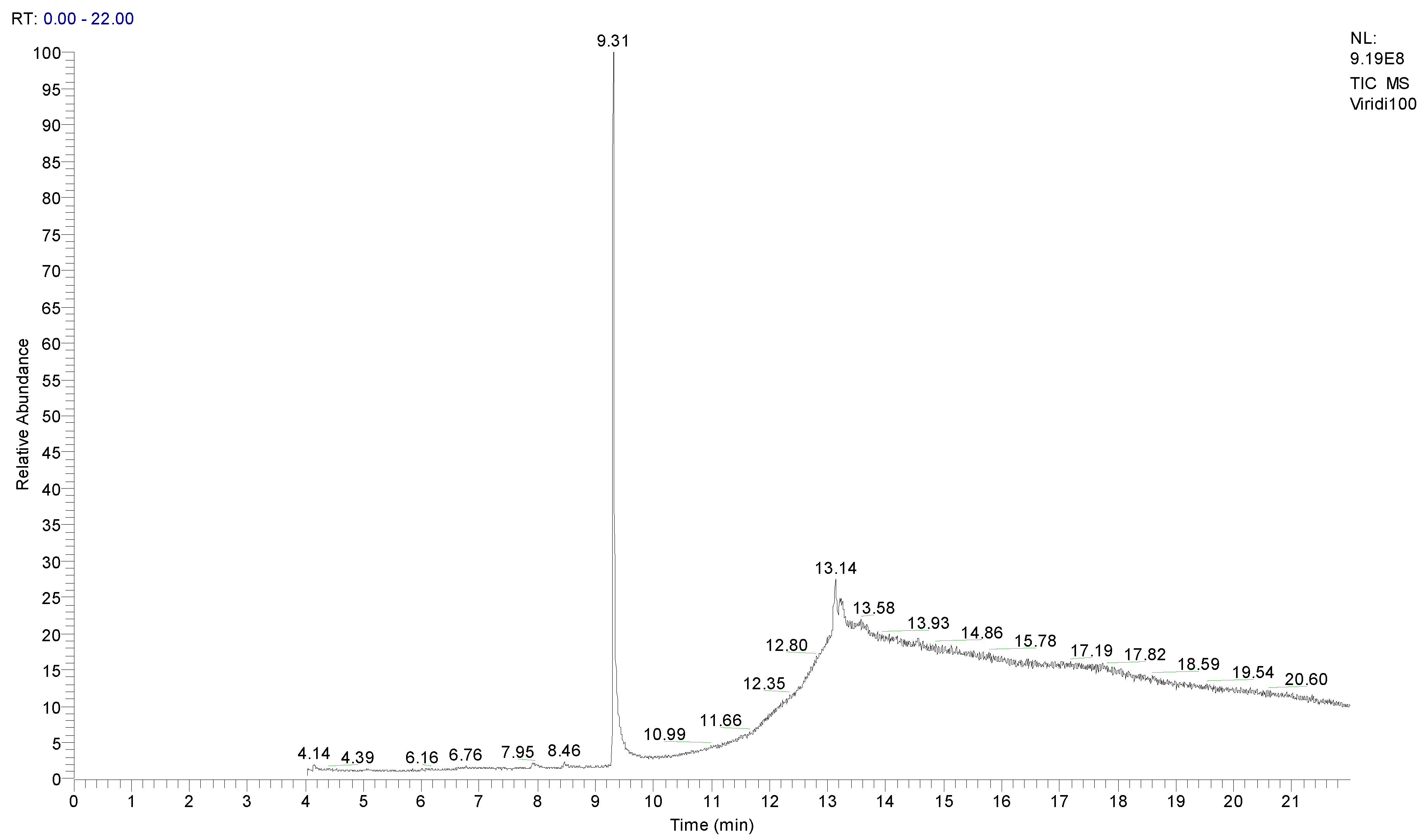
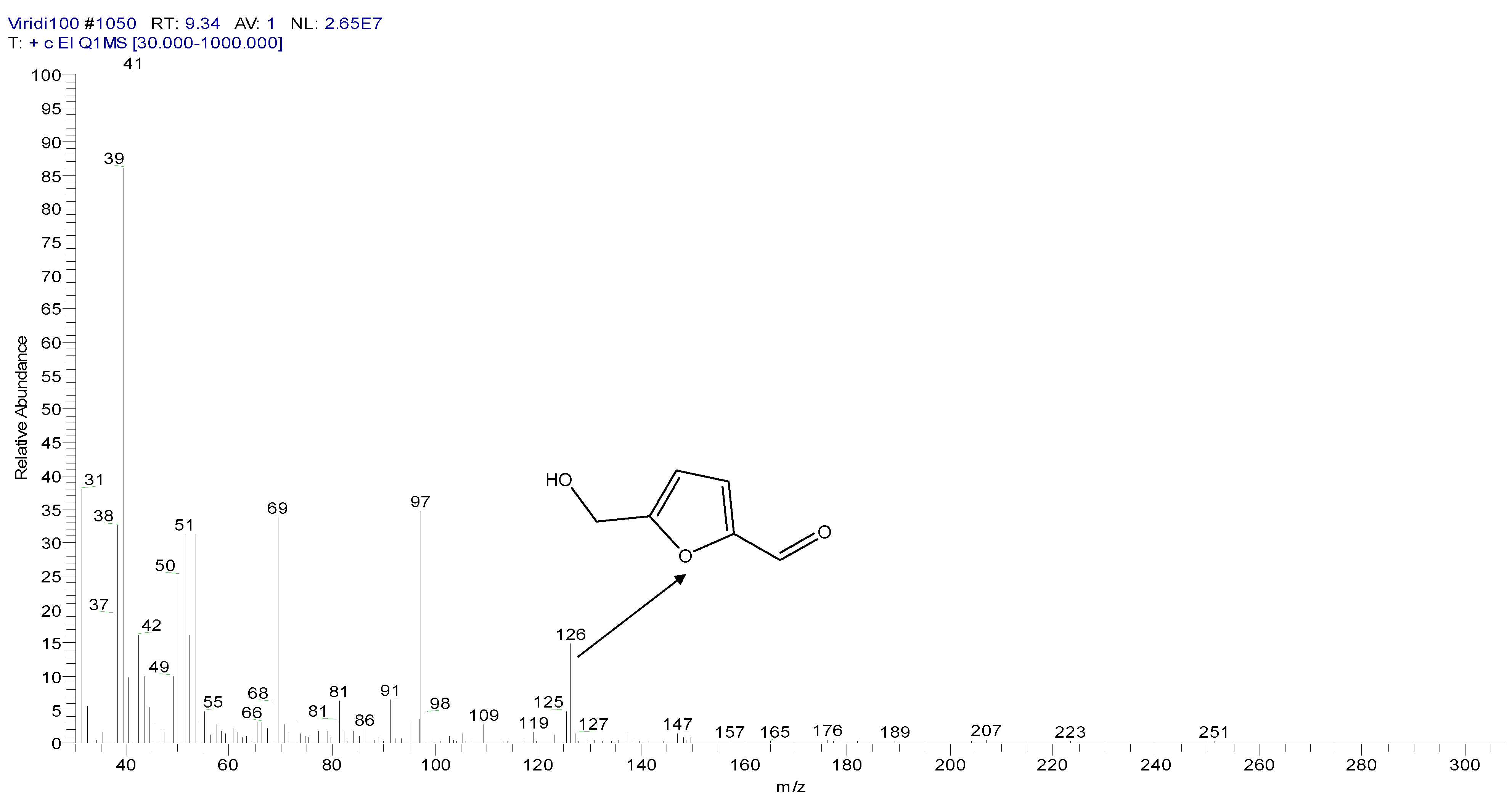
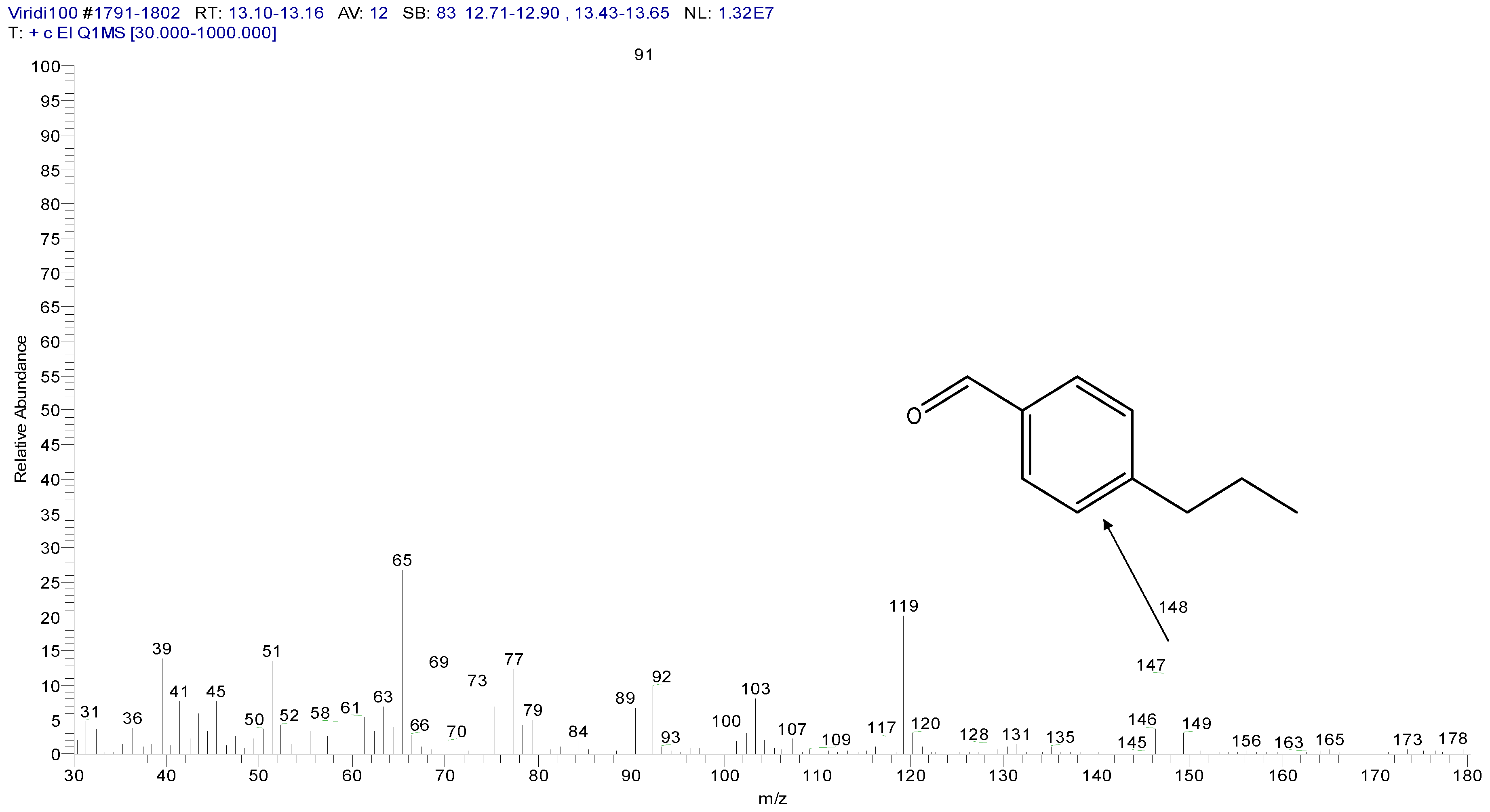
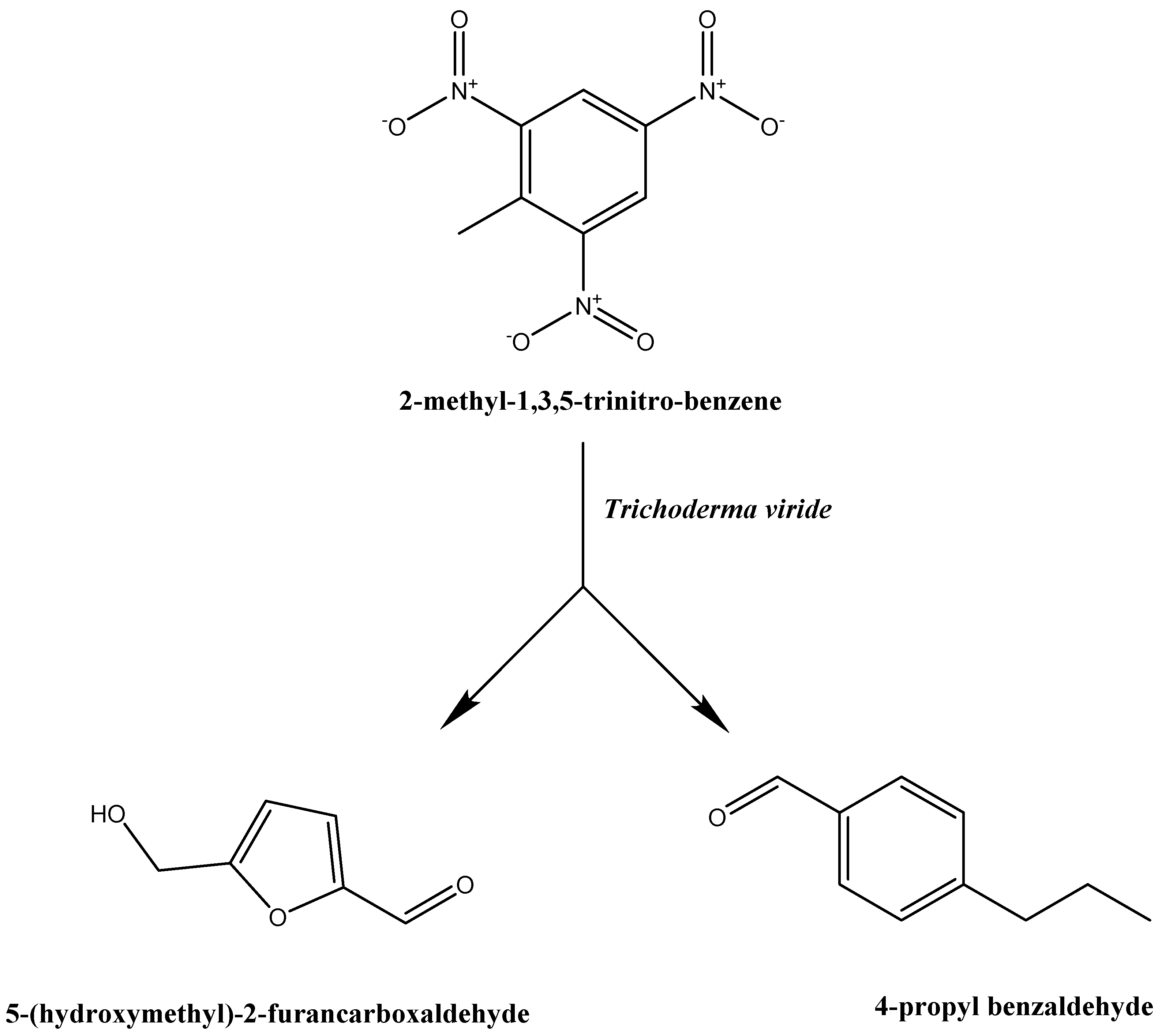
| Fungi | After 4 Days | After 8 Days | After 11 Days | |||||||||
|---|---|---|---|---|---|---|---|---|---|---|---|---|
| Control | TNT ± SD | Control | TNT ± SD | Control | TNT ± SD | |||||||
| C1 | C2 | 50 ppm | 100 ppm | C1 | C2 | 50 ppm | 100 ppm | C1 | C2 | 50 ppm | 100 ppm | |
| T. viride | 80.0 | 85.0 | 35.0 ± 2.0 | 32.5 ± 1.8 | 85.0 | 85.0 | 85.0 ± 1.9 | 85.0 ± 1.3 | 85.0 | 85.0 | 85.0 ± 2.1 | 85.0 ± 2.0 |
© 2020 by the authors. Licensee MDPI, Basel, Switzerland. This article is an open access article distributed under the terms and conditions of the Creative Commons Attribution (CC BY) license (http://creativecommons.org/licenses/by/4.0/).
Share and Cite
Alothman, Z.A.; Bahkali, A.H.; Elgorban, A.M.; Al-Otaibi, M.S.; Ghfar, A.A.; Gabr, S.A.; Wabaidur, S.M.; Habila, M.A.; Ahmed, A.Y.B.H. Bioremediation of Explosive TNT by Trichoderma viride. Molecules 2020, 25, 1393. https://doi.org/10.3390/molecules25061393
Alothman ZA, Bahkali AH, Elgorban AM, Al-Otaibi MS, Ghfar AA, Gabr SA, Wabaidur SM, Habila MA, Ahmed AYBH. Bioremediation of Explosive TNT by Trichoderma viride. Molecules. 2020; 25(6):1393. https://doi.org/10.3390/molecules25061393
Chicago/Turabian StyleAlothman, Zeid A., Ali H. Bahkali, Abdallah M. Elgorban, Mohammed S. Al-Otaibi, Ayman A. Ghfar, Sami A. Gabr, Saikh M. Wabaidur, Mohamed A. Habila, and Ahmed Yacine Badjah Hadj Ahmed. 2020. "Bioremediation of Explosive TNT by Trichoderma viride" Molecules 25, no. 6: 1393. https://doi.org/10.3390/molecules25061393
APA StyleAlothman, Z. A., Bahkali, A. H., Elgorban, A. M., Al-Otaibi, M. S., Ghfar, A. A., Gabr, S. A., Wabaidur, S. M., Habila, M. A., & Ahmed, A. Y. B. H. (2020). Bioremediation of Explosive TNT by Trichoderma viride. Molecules, 25(6), 1393. https://doi.org/10.3390/molecules25061393







